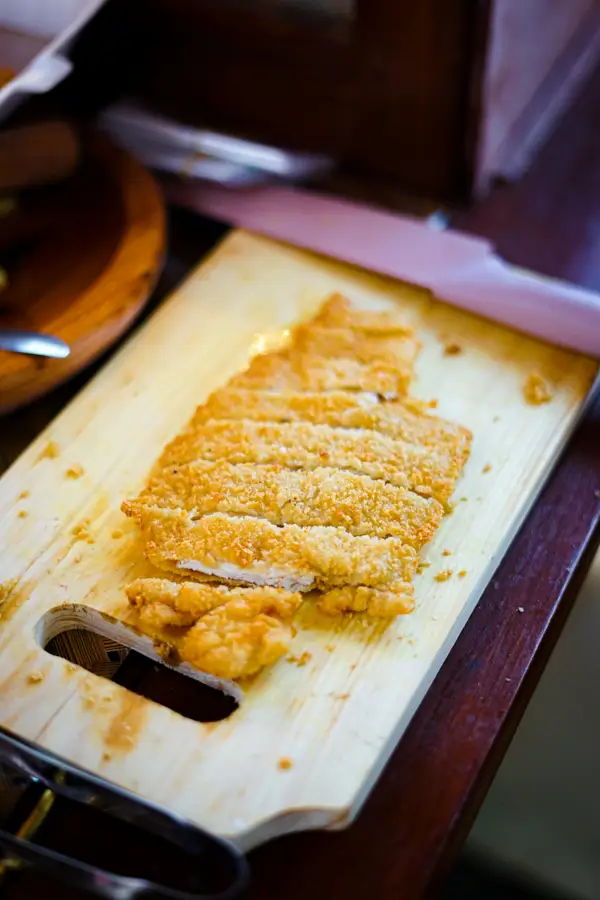Prepare yourself for a culinary journey into the heart of Central Europe with this guide on how to make Pork Schnitzel! This beloved dish, a thin, breaded, and pan-fried cutlet, boasts a rich history and cultural significance spanning centuries. While its exact origins are debated, most food historians point towards Vienna, Austria, as the birthplace of the modern Schnitzel. The 19th century saw the dish explode in popularity throughout the Austro-Hungarian Empire, quickly becoming a staple in everyday meals and celebratory feasts alike.
The word Schnitzel itself derives from the German word Schnitzeln, meaning to slice or cut. This reflects the crucial preparation step of pounding the meat to achieve its characteristic thinness. Early versions likely used veal, a more readily available meat for the aristocracy. However, as the recipe spread to wider populations, pork became a more common and affordable alternative, leading to the popular Pork Schnitzel we know and love today. Interestingly, variations exist across different regions, with slight differences in breading techniques and accompanying sauces reflecting local culinary traditions. For example, you’ll find variations featuring lemon wedges and parsley in Austria, while others might incorporate a creamy mushroom sauce in Germany.
The cultural significance of Pork Schnitzel extends beyond its delicious taste. It’s a dish that embodies comfort, tradition, and family meals across many Central European countries. Its popularity is undeniable, with countless variations and adaptations appearing in restaurants and home kitchens worldwide. While precise statistics on global consumption are difficult to obtain, its prominence on menus and its frequent appearance in home cooking worldwide clearly demonstrate its lasting appeal. From simple family dinners to sophisticated restaurant fare, Pork Schnitzel remains a testament to the enduring power of simple, yet exquisitely flavorful, cooking.
Ingredients and Measurements
Crafting the perfect Pork Schnitzel hinges on using high-quality ingredients and precise measurements. Here’s a breakdown of what you’ll need for approximately 4 servings:
Pork: You’ll need about 4 (6-ounce) pork cutlets, approximately ½ inch thick. Look for lean pork loin cutlets; they’re ideal for schnitzel because they’re tender and less prone to becoming tough during cooking. Avoid overly thin cutlets, as they’ll dry out easily, and avoid overly thick ones, as they may require longer cooking times and uneven browning. If your cutlets are uneven in thickness, gently pound them with a meat mallet to achieve a uniform ½-inch thickness. This ensures even cooking.
Flour: Use approximately 1 cup of all-purpose flour. Ensure the flour is fresh; stale flour can result in a less crisp coating. You might need slightly more or less depending on the size of your cutlets. Have extra flour on hand for dredging.
Eggs: You’ll need 2 large eggs. Use very fresh eggs for optimal binding. Whisk them thoroughly in a shallow dish to create a smooth, consistent coating. Add a tablespoon of water or milk to the beaten eggs for extra binding and a lighter batter.
Breadcrumbs: Use approximately 1 ½ cups of breadcrumbs. Panko breadcrumbs are highly recommended for their airy texture, which creates an exceptionally crispy schnitzel. If using regular breadcrumbs, ensure they are finely ground for a smoother, thinner coating. You can also add a touch of grated Parmesan cheese to your breadcrumbs for extra flavor.
Seasoning: Salt and freshly ground black pepper are essential. Season generously – about 1 teaspoon of salt and ½ teaspoon of black pepper for the pork cutlets. Don’t be shy with the seasoning! It’s crucial for flavor development. You might also consider adding other spices like paprika or garlic powder to enhance the flavor profile.
Oil for Frying: You’ll need about ⅔ cup of vegetable oil, canola oil, or a blend of oils with a high smoke point. Use enough oil to submerge at least half of the schnitzel in the pan. This ensures even cooking and a golden-brown crust. Avoid overcrowding the pan; work in batches to maintain the oil temperature.
Garnish (Optional): Lemon wedges and fresh parsley sprigs make excellent garnishes to serve alongside your delicious pork schnitzel.
Equipment Preparation
Before you begin preparing your pork schnitzel, ensuring you have the right equipment readily available and in optimal condition is crucial for a smooth and efficient cooking process. This will prevent delays and ensure a superior finished product.
You’ll need three shallow dishes, approximately 9 inches in diameter. These should be large enough to comfortably accommodate your pork cutlets without overcrowding. Avoid using overly deep dishes; shallow dishes allow for even coating.
The first dish will be for the flour dredge. Use all-purpose flour, approximately 1 ½ cups, for a standard batch of 4-6 schnitzels. More or less flour can be used depending on the quantity of pork. Ensure the flour is evenly spread across the base of the dish.
The second dish is for the egg wash. Crack two large eggs into this dish. Add 2 tablespoons of milk or water to the eggs and whisk vigorously until the mixture is light and frothy. This helps the breading adhere better to the pork. A fork or whisk works perfectly.
The third dish is for the breadcrumb coating. Here, you’ll need 2 cups of breadcrumbs. Panko breadcrumbs are recommended for their light and crispy texture, but regular breadcrumbs will also work. If using regular breadcrumbs, consider adding a tablespoon of grated parmesan cheese for extra flavor and crispness.
In addition to the dishes, you will need a meat mallet or rolling pin. This is essential for tenderizing and evening out the thickness of the pork cutlets. Aim for a uniform thickness of about ¼ inch to ensure even cooking.
Finally, gather your cooking utensils. You’ll need tongs or a spatula for handling the breaded cutlets, and a large, heavy-bottomed frying pan (at least 12 inches in diameter) is essential for even heat distribution. Choose a pan suitable for high heat and ideally one with a non-stick surface to prevent sticking. A thermometer to monitor oil temperature is also strongly recommended for optimal results. Remember to have paper towels ready for draining the cooked schnitzel.
By meticulously preparing your equipment beforehand, you’ll streamline the cooking process and improve the overall quality of your pork schnitzel. This organized approach will lead to a more enjoyable and successful culinary experience.
Pork Tenderizing and Preparation
Creating the perfect pork schnitzel begins with properly tenderizing and preparing the pork loin. We’ll be using about 1.5 pounds (680g) of pork loin, cut into 4 roughly equal pieces. This ensures even cooking and manageable portions. You can adjust the quantity based on your needs, but maintain a similar thickness for consistent results.
The key to a delicate, melt-in-your-mouth schnitzel is tenderizing the pork. While a meat mallet is traditional, a rolling pin works just as well. Place each pork piece between two sheets of plastic wrap. This prevents the meat from tearing and splattering while protecting your work surface. Using the flat side of the mallet or rolling pin, gently pound the pork to an even thickness of about 1/4 inch (6mm). Be careful not to over-tenderize, which can result in a tough schnitzel. The goal is to create a uniformly thin piece, not to pulverize the meat.
Once tenderized, trim any excess fat from the edges of the pork. A little fat adds flavor, but excessive fat can lead to overly greasy schnitzel. Aim for a clean, even surface. You can use a sharp knife for this. Season generously with salt and freshly ground black pepper on both sides. About 1 teaspoon of salt and 1/2 teaspoon of pepper per pound of pork is a good starting point, but adjust to your taste preferences.
For even more flavor, you can optionally add other seasonings at this stage. A sprinkle of paprika adds a lovely color and subtle smoky flavor, while garlic powder or onion powder enhances the savory notes. Remember to be mindful of the overall flavor profile you want to achieve. Don’t be afraid to experiment!
After seasoning, set the prepared pork aside while you prepare the breading station. Having everything ready before you begin breading ensures a smooth and efficient process. The key is to keep the pork cold until it hits the hot oil. This prevents it from becoming tough during cooking.
Professional Tip: For exceptionally tender schnitzel, consider marinating the pork for 30 minutes to an hour before tenderizing. A simple marinade of olive oil, lemon juice, and herbs can significantly enhance the flavor and tenderness of the meat.
Breadcrumbs and Breading Preparation
Creating the perfect schnitzel relies heavily on a crisp, flavorful breading. This section details how to prepare your breadcrumbs and execute the breading process for optimal results.
Choosing your breadcrumbs: While you can use store-bought breadcrumbs, making your own offers superior texture and flavor control. For homemade breadcrumbs, start with about 4 slices of day-old bread (challah, Italian, or even a sturdy white bread work well). Remove the crusts and cut the bread into 1-inch cubes. Spread the cubes on a baking sheet and bake at 300°F (150°C) for 10-15 minutes, or until completely dry and golden brown. Once cool, pulse the dried bread cubes in a food processor until you achieve a fine, slightly coarse crumb. Avoid over-processing, as this can create a powdery texture.
Quantity: For approximately 4 pork schnitzels, you’ll need about 2 cups of breadcrumbs. This may need slight adjustment depending on the size of your cutlets.
Seasoning your breadcrumbs: Don’t underestimate the power of seasoning your breadcrumbs. A simple blend of salt and pepper is a great starting point. However, for extra flavor, consider adding 1/2 teaspoon of garlic powder, 1/4 teaspoon of onion powder, and a pinch of paprika to the breadcrumbs. Thoroughly mix the seasonings into the breadcrumbs before breading.
Setting up your breading station: Efficient breading requires organization. Set up three shallow dishes: one for seasoned flour, one for beaten eggs (approximately 2 large eggs lightly whisked with 2 tablespoons of milk or water), and one for the prepared breadcrumbs. Having everything readily accessible speeds up the process and ensures even coating.
The breading process: First, dredge each pork cutlet in the seasoned flour, ensuring it’s fully coated. Shake off any excess flour. Next, dip the floured cutlet into the egg mixture, allowing any excess to drip off. Finally, press the cutlet firmly into the breadcrumbs, making sure they adhere evenly to all sides. Gently press to help the breadcrumbs stick better. Avoid over-handling the breaded schnitzel, as this can result in a heavy, dense breading.
Important Note: If you’re making a large batch, it might be helpful to have a wire rack nearby to place the breaded schnitzels on. This allows for air circulation and prevents the breading from becoming soggy before cooking.
Cooking the Schnitzel (Pan-frying/Deep-frying)
Now that your pork cutlets are prepped and ready, it’s time to cook them to crispy, golden perfection! You have two main options: pan-frying or deep-frying. Both methods yield delicious results, but offer slightly different textures and levels of crispiness.
Pan-frying is ideal for a slightly healthier option, requiring less oil. For this method, heat about 1/4 inch (approximately 6mm) of high-smoke-point oil, such as canola or vegetable oil, in a large, heavy-bottomed skillet over medium-high heat. The oil is ready when a pinch of breadcrumb sizzles immediately upon contact. Carefully place 2-3 schnitzels in the hot oil, ensuring not to overcrowd the pan. This will lower the temperature of the oil and result in soggy schnitzel. Cook for approximately 3-4 minutes per side, or until golden brown and cooked through. The internal temperature should reach 145°F (63°C).
Deep-frying produces an exceptionally crispy schnitzel with a wonderfully light and airy texture. For this method, fill a deep pot or Dutch oven with about 3 inches (approximately 7.5cm) of high-smoke-point oil. Heat the oil to 350°F (175°C) using a thermometer; never rely on visual cues alone. Carefully lower the schnitzels into the hot oil, ensuring they are not overcrowded. Fry for approximately 2-3 minutes per side, or until golden brown and cooked through. Again, ensure the internal temperature reaches 145°F (63°C). Remove the schnitzels with a slotted spoon and place them on a wire rack to drain excess oil. This prevents the schnitzel from becoming soggy.
Regardless of your chosen method, remember these crucial points:
- Do not overcrowd the pan or pot. Overcrowding will lower the oil temperature and result in greasy, soggy schnitzel.
- Use a meat thermometer to ensure the pork reaches a safe internal temperature of 145°F (63°C).
- Let the schnitzel rest for a few minutes after cooking before serving. This allows the juices to redistribute, resulting in a more tender and flavorful schnitzel.
- Adjust cooking time based on the thickness of your cutlets. Thicker cutlets will require longer cooking times.
Once cooked, serve your delicious schnitzel immediately with your favorite sides, such as potato salad, spaetzle, or a simple green salad. Enjoy!
Resting the Schnitzel
Resting your schnitzel is a crucial step often overlooked, yet it significantly impacts the final result. It allows the juices within the meat to redistribute, resulting in a more tender and flavorful schnitzel. Proper resting prevents the meat from becoming dry and tough, a common problem with thinly pounded cuts of pork.
After removing the schnitzel from the pan, place it on a wire rack set over a baking sheet. This allows air to circulate around the schnitzel, preventing it from steaming in its own juices. Avoid placing it directly on a plate, as this will trap moisture and lead to a soggy schnitzel.
The ideal resting time is 5-10 minutes for a typical schnitzel (approximately 1/4 inch thick). Thicker schnitzels may require a slightly longer rest, up to 15 minutes. This allows the muscle fibers to relax, absorbing the juices that have been drawn to the surface during cooking. Using a meat thermometer, ensure the internal temperature reaches 145°F (63°C) before resting.
During the resting period, resist the urge to cut into the schnitzel. This will release the precious juices, leading to a dry and less flavorful final product. Patience is key here; the few extra minutes of waiting will be well worth the improved texture and taste.
Gently tent the wire rack with aluminum foil during the last few minutes of resting if you notice the schnitzel is starting to cool too quickly. This will help retain some heat and prevent excessive moisture loss without trapping steam.
Once the resting period is complete, you can proceed to serve your perfectly cooked schnitzel. The meat will be significantly more juicy and tender, showcasing the best of the pork’s flavor. Remember, a well-rested schnitzel is a testament to careful cooking and attention to detail – a delicious reward for your efforts. Enjoy!
Pro Tip: For even more flavorful results, consider basting the schnitzel with melted butter or a pan sauce during the last minute of cooking before resting. This adds richness and depth to the overall taste.
Recommendations
For the best Pork Schnitzel, ensure your pork cutlets are pounded evenly to an even thickness. This ensures even cooking and prevents some parts from being overcooked while others remain undercooked. Using a meat mallet is recommended for this process. Also, don’t overcrowd the pan when frying; work in batches to maintain a consistent oil temperature for optimal browning and crispiness. Overcrowding will lower the oil temperature and lead to greasy schnitzel.
Serving suggestions are plentiful! Classic pairings include potato salad, German potato dumplings (Kartoffelknödel), or simply some roasted potatoes. A vibrant green salad with a light vinaigrette cuts through the richness of the schnitzel beautifully. For a more substantial meal, consider serving it with spaetzle, a type of egg noodle. Don’t forget a lemon wedge for squeezing over the top – the acidity brightens the flavor profile beautifully.
Storage: Leftover schnitzel can be stored in an airtight container in the refrigerator for up to 3 days. To reheat, gently warm it in a non-stick pan over medium heat, or use a microwave. Avoid reheating for extended periods, as this can lead to a tough texture. Freezing is also an option; wrap individual portions tightly in plastic wrap, then place them in a freezer-safe bag for up to 3 months. Thaw overnight in the refrigerator before reheating.
Nutritional Information (per serving, approximate): Calorie count will vary depending on the size of the schnitzel and the type of breading used. However, a typical serving might contain around 400-500 calories. This includes a significant amount of protein from the pork, along with carbohydrates from the breading and any accompanying side dishes. Fat content will also be relatively high due to the frying process. Specific nutritional breakdowns (e.g., fat, protein, carbohydrates) will require a precise recipe and ingredient list to be accurately calculated.
Complementary Dishes: To make your meal truly memorable, consider adding a side of tangy sauerkraut or a creamy mushroom sauce. A simple cucumber salad provides a refreshing contrast to the richness of the schnitzel. A light and flavorful cucumber salad with a dill dressing would be ideal. Experiment with different sides to find your perfect combination!





